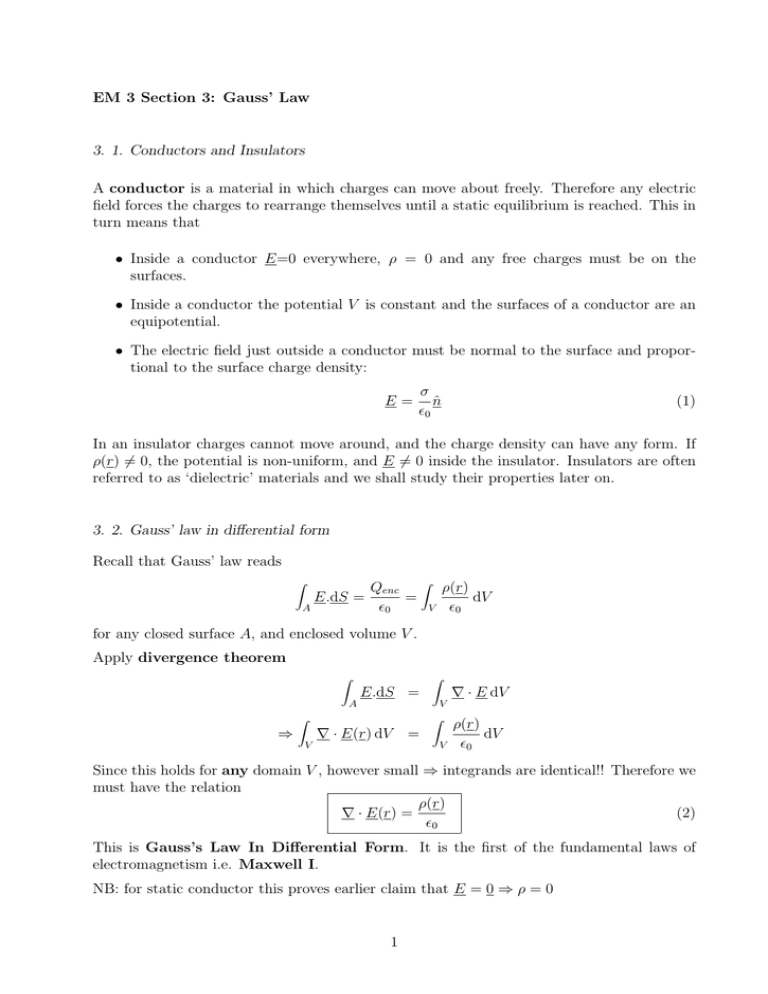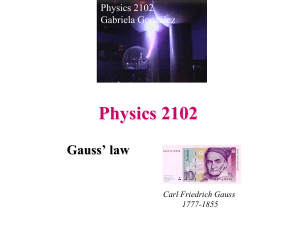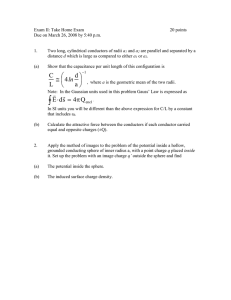EM 3 Section 3: Gauss` Law 3. 1. Conductors and Insulators A
advertisement

EM 3 Section 3: Gauss’ Law 3. 1. Conductors and Insulators A conductor is a material in which charges can move about freely. Therefore any electric field forces the charges to rearrange themselves until a static equilibrium is reached. This in turn means that • Inside a conductor E=0 everywhere, ρ = 0 and any free charges must be on the surfaces. • Inside a conductor the potential V is constant and the surfaces of a conductor are an equipotential. • The electric field just outside a conductor must be normal to the surface and proportional to the surface charge density: E= σ n̂ 0 (1) In an insulator charges cannot move around, and the charge density can have any form. If ρ(r) 6= 0, the potential is non-uniform, and E 6= 0 inside the insulator. Insulators are often referred to as ‘dielectric’ materials and we shall study their properties later on. 3. 2. Gauss’ law in differential form Recall that Gauss’ law reads Qenc Z ρ(r) = dV E.dS = 0 V 0 A Z for any closed surface A, and enclosed volume V . Apply divergence theorem Z E.dS = A ⇒ Z Z ∇ · E dV V ∇ · E(r) dV V = Z V ρ(r) dV 0 Since this holds for any domain V , however small ⇒ integrands are identical!! Therefore we must have the relation ρ(r) ∇ · E(r) = (2) 0 This is Gauss’s Law In Differential Form. It is the first of the fundamental laws of electromagnetism i.e. Maxwell I. NB: for static conductor this proves earlier claim that E = 0 ⇒ ρ = 0 1 Aside expressions for the divergence in cylindrical and spherical polar coordinates: ∇·E = 1 ∂(ρEρ ) 1 ∂Eφ ∂Ez + + ρ ∂ρ ρ ∂φ ∂z (3) 1 ∂(r2 Er ) 1 ∂(sin θEθ ) 1 ∂Eφ ∇·E = 2 + + r ∂r r sin θ ∂θ r sin θ ∂φ (4) These are nasty and you do not need to remember them, but they simplify in the case of cylindrical or spherical symmetry e.g. if our system is spherically symmetric it means that there is no distinguished direction or position therefore the electric field must have no angular 1 ∂(r2 Er ) dependence and must be radial i.e. E = Er (r)er . Then ∇ · E = 2 . r ∂r 3. 3. Examples of Gauss’s Law Griffiths 2.2.3 “Gauss’s law affords when symmetry permits by far the quickest and easiest way of computing electric fields”. Note well the qualifier when symmetry permits. Basically there are 3 kinds of symmetry which work and for which the following gaussian surfaces for the surface integral in Gauss’ law are appropriate 1. Spherical symmetry : concentric sphere 2. Cylindrical symmetry : coaxial cylinder 3. Plane symmetry : a “pill box” Example 1: Insulating sphere Let us return to the example of the previous lecture i.e. an insulating sphere with a uniform charge density ρ. Inside the sphere (r < a): Er = ρr 0 3 ∇·E = 1 ∂(r2 Er ) ρ 1 ∂r3 ρ = = 2 2 r ∂r 30 r ∂r 0 Outside the sphere (r > a): Q Er = 4π0 r2 Q 1 ∂ ∇·E = 4π0 r2 ∂r so Gauss’ law holds. 2 r2 r2 ! =0 Figure 1: A cylindrical surface around line charge (Griffiths Fig 2.21) Example 2: Line charge For an infinite line charge, λ, by symmetry Ez = Eφ = 0, and the closed surface is chosen to be a cylinder of length l and radius a with the line charge as its axis. N.B. here ρ is the radial coordinate of cylindrical polars ΦE = Eρ 2πρl = λ l 0 λ 2π0 ρ Compare this method to summing the Coulomb forces in the previous lecture! Eρ = Example 3: Surface charge For an infinite surface charge, σ, the closed surface is chosen to be a circular “pillbox” of radius, r, and height h, with its axis normal to the surface and its centre at the surface. Note - from the symmetry of the problem the electric field parallel to the surface is zero. Figure 2: Diagram of Gaussian pillbox around surface charge sheet (Griffiths Fig 2.22) If the surface is a thin insulating sheet there are equal and opposite perpendicular electric fields on either side of the sheet: σ σ ΦE = 2Ez πr2 = πr2 Ez = (5) 0 20 If instead the charge is on the surface of a large conducting object, the inside of the conductor has E = 0, and the only contribution to the flux comes from the electric field normal 3 to the outer surface Ez = σ as quoted at the beginning of the lecture. 0 Note the factor of two between the conducting surface and the thin insulating sheet! ∂Ez = 0 for z 6= 0 but the ∂z electric field is discontinuous across the charge sheet at z = 0 with discontinuity σ/0 . We can write the Electric field for all z using a step function Remark: In both both insulating and conductor cases ∇ · E = ( Θ(z) = 1 for z > 0 0 for z < 0 e.g. for the conducting sheet Ez = σ Θ(z) 0 δ(z) = d Θ(z) dz Then we use the identity (6) and find that ∂Ez σ = δ(z) ∂z 0 Which is consistent with Equation (2) with a source of charge at z = 0. ∇·E = (7) 3. 4. A delta function identity and point charges (see tutorial 1.3) Consider the vector field r̂ r2 Now this is a spherically symmetric field with vr = 1/r2 so using div in spherical polars v= 1 ∂ 1 ∇·v = 2 r2 2 = 0 r ∂r r But clearly the integral over a spherical surface radius r I v · dS = 4πr2 vr = 4π (8) (9) So Gauss’s theorem which should relate the two results appears to yield a contradiction. The source of the problems is r = 0 where v diverges (is singular). The contradiction can be resolved by noting that actually r̂ ∇· 2 r then Z ! = 4πδ(r) ∇ · v dV = 4π V Z (10) δ(r) dV = 4π V Identity (10) implies that ∇ · E = ρ/0 holds even for a point charge for which ρ = qδ(r) q r̂ and E = 4π0 r2 4


